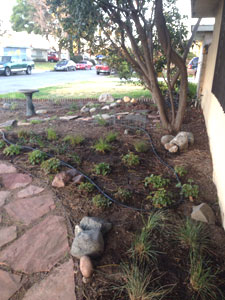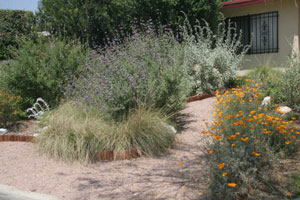Now is the Time . . .
by Gabi McLean
(reprinted from the Naturalist Notes, Jan-Feb 2015, Sierra Club, Angeles Chapter, Natural Science Section)
|
Have you ever missed the opportunity to enjoy nature, because you are short on time rushing to work every day, or short on money for gas driving to the coveted mountains, foothills, and canyons of Southern California? Have you ever missed the smell of wild sage? The soothing smell of wet soil? The buzz of busy bees and other colorful insects that pollinate eye-catching and humble flowers alike? Have you ever missed the bright colors of wild flower? The shade of evergreen shrubs and trees? The wild fruits that brighten summer, fall, and winter? Have you ever lamented the loss of natural habitat where you live? Natural habitat is a place with vegetation suitable for birds, bees, other insects, reptiles and amphibians, and of course mammals. It is a place for us human folks to enjoy and connect with nature. So loss of natural habitat understandably has many of us saddened and concerned. 
Have you ever wondered how to solve the dilemma of 15 million people (you and I are among them) living in a semi-arid area that does not have enough rainfall or ground water to satisfy our current demands for this most precious resource? |
Now is the time to do something about all of this. Now YOU can create natural habitat, a place to enjoy nature right where you live, and—as a side product—save this most precious natural resource, water. Now is the time to plant your native plant garden! Plant in your suburban yard, or your foothill property, even on your balcony you can create a miniature habitat. Now that the rains have come, now that the earth is ready to nourish the seeds and seedlings and young plants, now is the time to plant them. You’ll have a few months to figure out the right watering schedule—keep the soil moist through the winter and spring—and give the plants a good start to establish themselves before the summer heat and drought sets in. 
Have you ever sighed in desperation when you got your water bill? Well, fret no more. With drought tolerant native plants, a weekly watering for new plants, and every two to three weeks watering for established plants, maybe even only monthly watering, your water bill will be greatly reduced. So I haven’t convinced you yet? Here is another reason: most municipalities will give you a financial incentive to convert your lawn to drought resistant plantings. Some will pay half of the cost for drip irrigation on a timer even if you haven’t had a lawn before and are just overhauling your irrigation system. Check out your local water district. Most have established some really great incentive programs you can use to reduce the initial cost on going native on a larger scale. Now is the time! It will sooth the soul and make you happy. That is what our native garden has been doing for me. |
Keywords: Gabi McLean, Cliff McLean, Gabriele McLean, Clifford McLean, Nature at Hand, Gabi Horn, Gabriele Horn, Plants of the San Gabriel Mountains: Foothills and Canyon, Interpretive Guide on CD, Plants of the San Gabriel Foothills and Canyons, California native plants, Pasadena, Los Angeles, Los Angeles County, San Gabriel Valley, Southern California, Covina, natural, nature photography, photograph, environmental education, naturalist, docent, hike, hiking, CD-ROM, California native garden, gardening, flowers, wildflowers, San Gabriel Mountains, Angeles National Forest, Station Fire, fire recovery